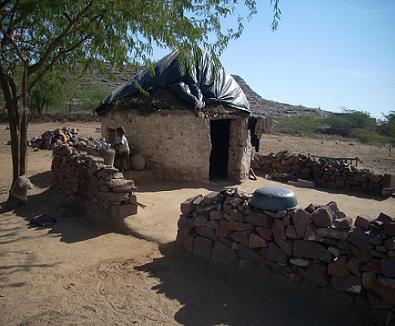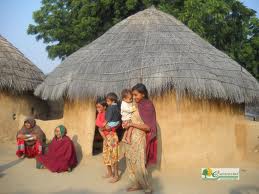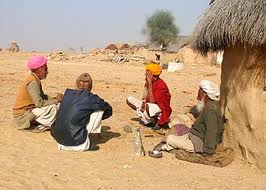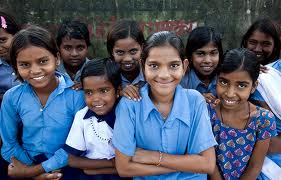Villages in Rural Rajasthan
|
|
Far from
the royal cities of the state, the villages of Rural Rajasthan hold
their own distinct charm. Though they usually lack any attraction in
form of forts, palaces, gardens and wildlife sanctuaries, yet they
are worth visiting for the simple reason that they present the life
of Rajasthan at its most basic. The rural life of Rajasthan reflects
the determination of the people to survive in even most difficult of
circumstances. For a tourists visiting Rajasthan for the first time,
it is actually difficult to find a village in the vast stretches of
barren land. It is only when a herd of cattle is seen around that
the tourist gets an inkling of a village in close by area. Many a
times, interestingly, even these signs are not seen and the tourists
acknowledges the existence of a village only upon entering it. Once
in the village, tourists realize that they have reached a place that
is most simple and has perhaps remained static over last many years.
The state of Rajasthan is populated with deserts. In spite of the
challenges that these deserts offers, people have settled all over
the Thar Desert and have innovated in their own small ways to make
the arid sands habitable.
The
landscape of Rajasthan is scattered with villages and hamlets,
telltale signs of tree groves and populations of cattle being the
only indication that there is such a settlement in close proximity.
The most beautiful villages are situated in the Shekhawati region of
Rajasthan. |

|
|
|
|
Water
plays an important part in deciding the location of villages in
Rajasthan. Water is literally like nectar or amrut (ambrosia) in
Rajasthan. People and animals in Rajasthan can manage without water
for a considerable period. The women also manage their chores with a
minimum of water. For cleaning vessels, they use a piece of cloth
and fine sand, which is available in plenty. Brass and copper
vessels, plates and tumblers acquire a shiny look after they are
cleaned with sand. Then, they are washed with very little water and
are ready for use. Bikaner, a western district in Rajasthan was
named so as water (ner) was sold (Bika) there. In Jodhpur water was
delivered through the railway. In Jobnair also, water was sold like
any other commodity. Small tanks and wells were guarded by watchmen.
A village well is the hub of activity in the morning. People who
cannot afford to purchase water draw water from the well in earthen
pitchers by themselves. In villages, the villager can offer a glass
of buttermilk to his guests.
|
 |
|
But he
cannot offer as much water, which the women-folk carry from a great
distance, which is about one to two miles. The water in earthen pots
becomes ice-cold in the summers. A baby is also bathed in a thali or
dinner plate with a piece of cloth for a sponge and very little
water. Camels are integral part of the many households in Rajasthan,
and are used for transportation, travel and amusement. Camel
load-lifting competitions and camel races take place on festive
occasions. Each house has a huge gate for camel and only a very
small door for people.
|
|
The
hamlets, the most basic form of civilization, that has probably
remained unchanged since centuries, consist of a collection of huts
that are circular and have thatched roofs.
The houses of
villages are fully ornamented with paintings on the walls and the
walls of the village are also painted. The walls and houses are
ornamented by creating a texture in the plaster, or by using simple
lime colours to create exciting patterns at the entrance and outside
the kitchen. These are prepared
from a combination of sun baked clay bricks which are enclosed with
plaster of lime. The floors are constructed from a mixture of
limestone stones, water and pounded lime. The villages have
agricultural and idyllic settlements, sanctuaries and temples.
There are also temples which are devoted to, Shiva, Krishna, and
Ram. These shrines are situated a little outside the village and are
enclosed by trees that are cultivated by the villagers. The wells of
the village are often richly ornamented and have tall pillars that
would demonstrate their presence for travelers on long journeys
through the desert.
|
|
Every house in Rajasthan will also have a small room where people
would fold their hands and pray to the god. To seek sympathy from
the gods people pray to the goddess Kali to protect them from the
evil spirits and the illness of mankind. Some of the images of the
local deities like the Sagasji and Bhairuji are outside the houses
of the people and the images of deities are also in the villages
kept in the roots of peepal tree. When one lives so close
to the elements, it is natural to want to bow before them: a little
obeisance can mean so much in the struggle for existence.
Mina tribes in Chittorgarh practice an another form of medicine
known as extra sensory perception (ESP). In this treatment, a Bhopa
or priest enter into a trance and use a form of trapped energy to
cure the illnesss of pains and other disorders. In case of injuries
ash is used as an antiseptic.
The
kitchen in a village house is at its centre since this is where
storage and cooking go hand in hand. Families rise early, with women
beginning the day's tasks with the milking of cattle.
|
 |
|
Many families
maintain dairies, and carry the milk to urban areas for selling.
Peasants who work on their farms leave for work after a glass of
piping hot tea, carrying their spartan lunch with them. It is in the
evenings that families tend to get together to dine. Generally, the
male members eat first, the women next. In winter, people dine in
the kitchen itself, sitting in front of the hearth.
Clay pots are placed for cooking over this stove. Mostly the meals
are vegetarian. Dinner is an important meal of the family, in the
dinner. One of the important meal of the family is the dinner where
oats and baked bread is served with a karhi, fresh vegetables and
dried beans. For most of the families, the
breakfast consist of a full glass of hot tea and bread, and lunch
consists of an unleavened bread eaten with a spicy chutney of
chillies and garlic. Non vegetarian dishes are restricted to only
special occasions and festivals.
|
|
In the villages the different castes of the village create a
structure of dependence based on the nature of their work and each
village is a multi-community settlement. At the head of village
settlement resides the Rajputs. The village life rotates around
Rajputs. In fact, the cattle density in
Rajasthan is very high and milk from desert settlements is supplied
to the large cities close to the state, including Delhi.
Rajputs also appoint bards and ministers who sang their praises in
song and poetry; the tradesmen who supplied them, and the others in
the community, with the goods required for their daily lives and
also also there were cloth dyers, printers, carpenters, potters and
ornament makers.
The priests of the Brahmin families cast horoscopes, performed the
elaborate rituals of their festive ceremonies, and served at the
temples. The Pathwari looked after those setting out
on journeys and pilgrimages. And there were various folk heroes and
gods who provide immunity from everything from snake bites to cattle
diseases.
|
|
The
births, betrothals, marriages, and deaths were the certain occasions
where the entire village would come together, and participate in
each otherís good and bad times.
People assemble in very large number at some places of the villages.
These places are wells, shops, shrines and village square which is
peepal tree with a large platform built around it for people to sit
on. For the wedding the cooking was done in a large scale. Whole village
dresses up properly to greet the wedding procession and the Dholis
and other people of the singing caste lead the party to the house
where the wedding is celebrated. Such celebrations are organized for
some days and became the social event of the season. Womens come out
of the villages only during the occassions of fairs and festivals.
These womens are always dressed in skirts or ghagras with a blanket
on their face and lot of jewellery on their face and forehead. In
the same way as women decorate themselves and decorate
|

|
|
their houses, the men also wear rings in their ears and slip their
feet into embellished shoes, they also create special jewellery for
their camels, or cut their coats in elaborative designs.
The camel is the beast of burden ideally suited for the desert. Its
ability to store enough water in its stomach to last it for a few
days makes it ideal for long distance travel along routes where even
wells may be a rarity. No wonder there is such close amity between
the long-legged beast and its owner. From transport to ploughing in the fields to pulling carts, the camel
even provides milk though its sweet, thick consistency is not
pleasing for everybody. In death, its hide finds use for converting
into leather for saddles, bags and shoes.
|
Now, some
changes have been made in the structure, and ceilings are made on
land holdings.
Most of the rural villages of Rajasthan now have various facilities
like telephones, electricity, televisions and a network of roads
from where people can travel more easily between villages and to the
nearby areas.
Life in the desert is in a stage of change but the traditions still
remain the same which were not just essential in the earlier times
but also gave life its unique merge of flavours.
|
|
For a
tourist, the ideal way to visit a village is on the back of a camel.
The most interesting sights that grabs the attention of tourists are
the women around the community well or a group of people discussing
important issues related to their village or general topics like
politics or children either studying in an open air school or
running around with complete freedom. The tourists can get a better
insight into the life of rural Rajasthan by interacting with these
people.
|
|
|
|
|
www.indovacations.com
Copyright © Indo Vacations team.
All Rights Reserved. |